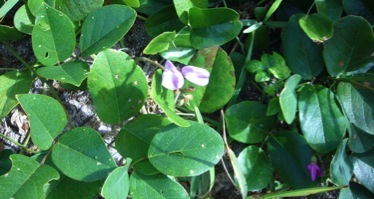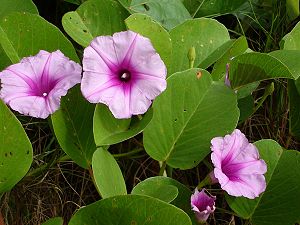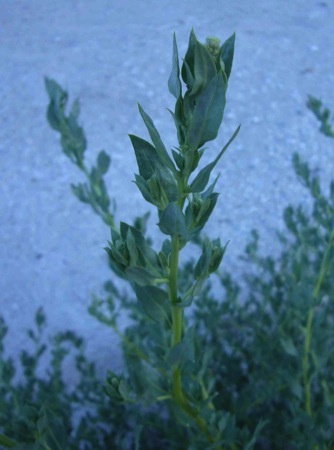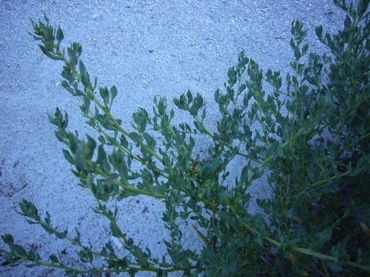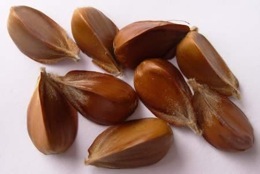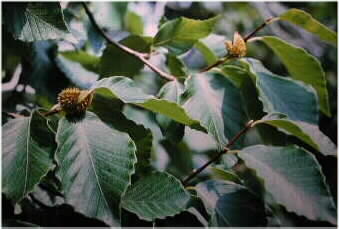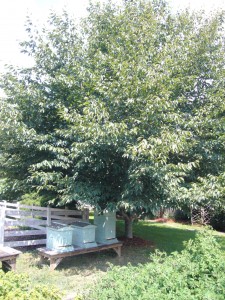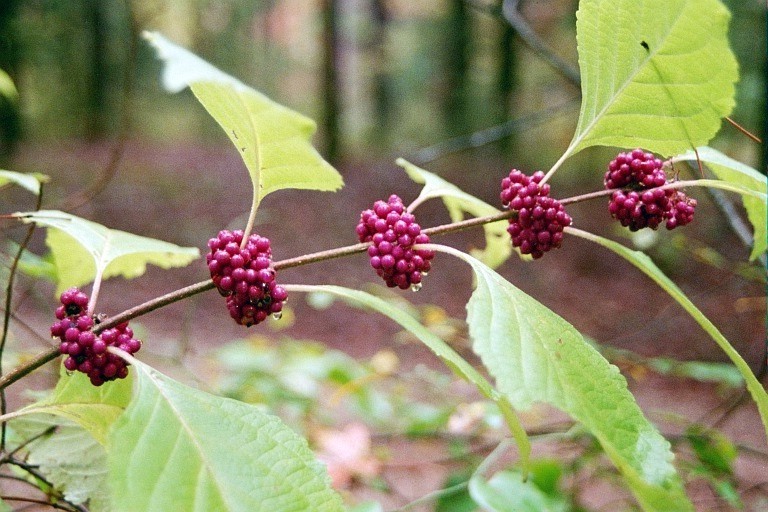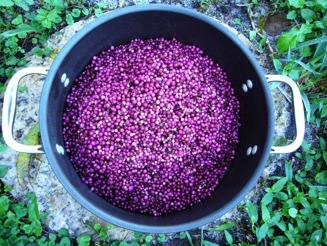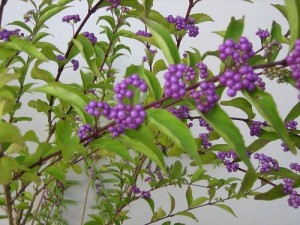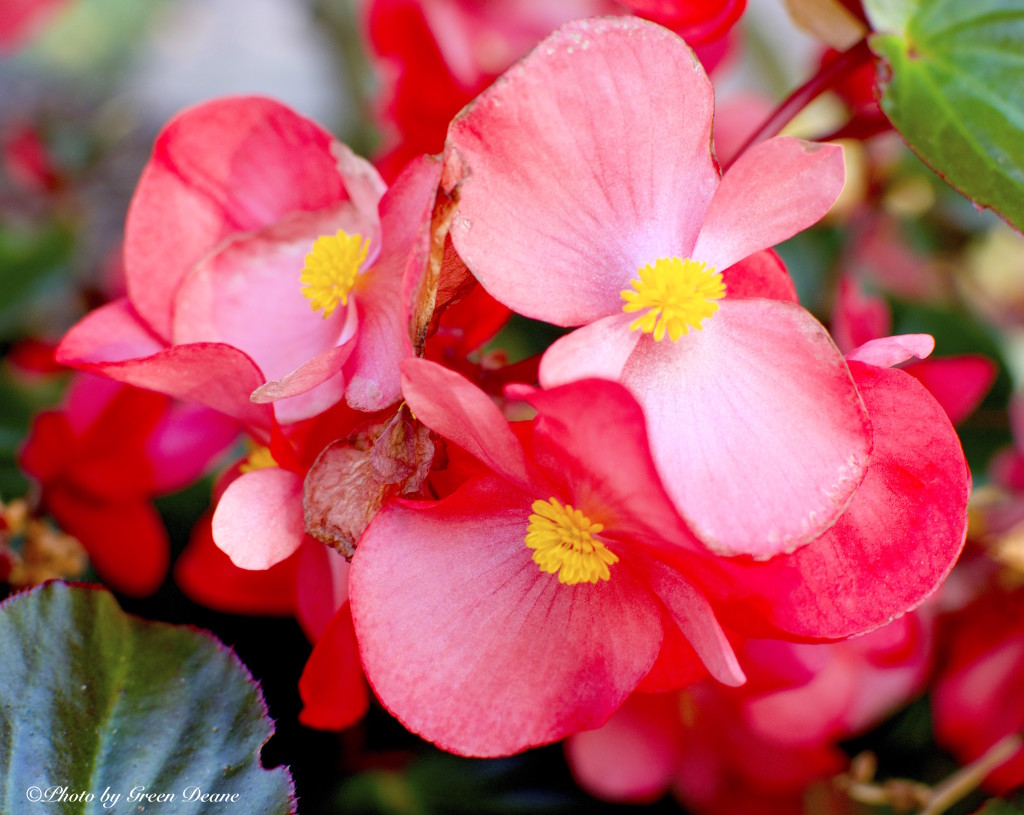
The flavor of Begonia blossoms and leaves changes with their color. Photo by Green Deane
Waxing about Edible Begonias
It was on Rock Springs Run, some 33 years ago here in Florida, when I first saw them, just above the variable water line. I couldn’t believe it: Wax Begonias, the most common houseplant in the world, in the middle of the swamp, and edible. I next saw them some 17 crow-fly miles away on a damp bike trail. And most recently they were in another county by a stream some 30 miles off to the southwest. The Wax Begonia is just one of many “invasive weeds” in central and southern Florida, spreading by seed. But, you can also find it in cemeteries in the summertime, on front porches, flower beds and in south-facing windows everywhere in the winter.
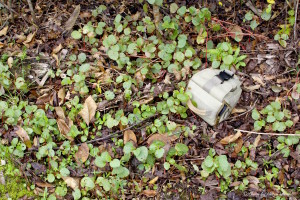
Begonias are naturalized in Florida. Photo by Green Deane
Known as Begonia cucullata [Beg-GOH-nee-uh kuk-yoo-LAY-tuh or kew-kew-LAY-uh) (previously B. semperflorens, sem-per-FLOR-enz) the fleshy leaves and flowers are edible raw or cooked. They can have a slight bitter after taste and if in water most of the time, a hint of swamp in their flavor. Sauteed alligator with Begonia sauce might be a musty challenge to the pallet. (See recipes below.) The B. cucullata is not the only edible Begonia. The popular Begonia X tuberhybrida (too-bur-HY-brid-uh) also has edible leaves and flowers. Very delicate and also very colorful, the B.X. tuberhybrida does not grow in the wild but that does not mean you can’t find them for nibbling. There are two cautions, however: Begonias contain that overrated tart threat, oxalic acid, and since they are primarily only found under cultivation make sure they haven’t been treated with pesticides and the like. While the escaped Wax Begonia has but a few colors (red, pink, or white) and simple flowers, the tuberhybrida comes in many colors and the flavor varies with the color. Its blossoms are also more complex, often doubled.
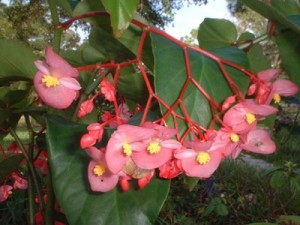
Wax Begonia Blossoms
The Journal of Economic Botany has mentioned edible Begonias several times since the 1940’s including an article on them in 1992, pp.114-115. There are at least a baker’s dozen plus more edible species of Begonia than those already mentioned making at least 15: B. annulata (aka B. hatacoa) B. auriculata, B. barbata, B. gracilis, B. grandis var evansiana (sparingly), B. hernandioides, B. malabarica, B. mannii, B. picta, B. palmata, B. plebeja (stems peeled, sap is used to make a drink) B. Semperflorens, B. rex and B. roxburghii (cooked.) B. fimbristipula is used to make a tea. Among those are tuberous, non-tuberous, hybrid and non-hybrid begonias. There are also reports of numerous other Begonias being consumed in several countries, from Mexico to India. Wherever they grow they have been important to people. They are a good source of food and medicine and vitamin C, long eaten to prevent scurvy. Begonias have been cooked up as potherbs in Japan, India, Indonesia and Myanmar (Burma.) They are used to make a sauce for meat and fish in Indonesia, salads in China, Indonesia and Brazil. In Java, the Philippines and Brazil they are also a flavoring ingredients. In northern Mexico and China they are a favorite wild snack for children. In fact, some rural people use the tart sap to curdle milk for cheese making.
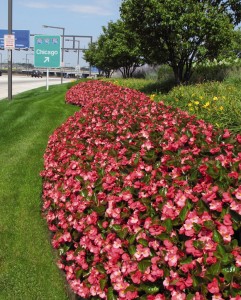
Begonias are a common bedding plant. Make sure they have not been sprayed.
In Paraguay the leaves of the B. cucullata are eaten fried or in soup or salads while the sap is used to treat sore throats. As just mentioned, Begonias have had numerous medicinal applications. One of them, using B. malabarica to affect glucose levels, has been shown to be effective in diabetic rats, echoing its folk use in people. In the West Indies those under the weather use Begonia leaves as a tea for colds. Roots and tubers of Begonias have been a mainstay of folk medicine for centuries. They have been used as emetics, purgatives and cathartics. The sap has been put on wounds, and concoctions used for cough, consumption, and fever. Shoots have been used to treat upset stomachs and enlarged spleens. The acid-based sap has been used to treat toothaches and gum aliments. It is anti-bacterial. Elements in the Begonia have been proven to have anti-tumor activity and it is commonly used in the West Indies by herbalists to treat cancer. A few websites say Wax Begonias are cancer-causing but I cannot find any research to support that assertion. In fact, I found just the opposite with a related species. A study reported in the Journal of Ethnopharmacology, Volume 124, Issue 1, 6 July 2009, found: “Cucurbitacin B, E, I and dihydrocucurbitacin isolated from Begonia nantoensis were reported to have cytotoxicity in cancer cell lines.” The assertion that wax begonias can be carcinogenic can be traced back to at least a 2007 Public Broadcasting Service webpage recipe quoting two chefs from a 2003 copyrighted work. The chefs also say only the petals of the tuberous begonia are edible. I think they got that from an older and equally wrong book on edible blossoms. Many non-tuberous Begonias are edible. Numerous “edible flower” websites, cut and pasting each other and not doing any homework, have perpetuated the errors. Let’s set the record straight: Begonias other than tuberous have edible leaves and blossoms.
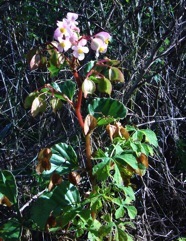
Wax Begonia blossoms
The most common house plant in the world — the Wax Begonia — came from Brazil’s Atlantic Coastal Forest (where it is used like spinach and a diuretic.) Begonias are native to South America, Central America, South Africa and Asia though most of the hybrids come from the Wax Begonia. The genus name Begonia comes from Michel Begon, a 17th-century governor of Santo Domingo, and amateur botanist. Naming the genus after Begon was a good idea but not without some politics. Begon was governor of the French Antilles from 1682 to 1685. Botanist Charles Plumier had been recommended by Begon to King Louis XIV to be the official plant collector in the French Caribbean. Plumier got the job and he rewarded Bergon by naming the plant after him. A symbiotic relationship, it would seem. Cucullata means hooded, a reference to the shape of the flowers. Semperflorens means ever flowering, and, tuberhybrida is tuberous hybrid. Begonias have been cultivated for at least 1,400 years starting with B. grandis in China. It was used in herbal medicine as an astringent to clean wounds, reduce swelling and to treat a number of diseases. B. fimbristipula (fim-bree-STEE–pou-la) is made into a bitter, purple tea, and can sometimes be found in your local Chinese market. Begonias got to Japan in 1641 and then England in 1777. By 1847 there were between 70 and 80 species of Begonias growing in Europe. They were in the United States by 1850 but really took off after World War I. There are now some 1,600 species and at least as many cultivars. Besides the Wax Begonia, the American Begonia Society recognizes seven other horticultural types: Cane-like, Shrub-like, Thick-stemmed, Rhizomatous, Rex-hybrids, Tuberous and Trailing-Scandent. Yet, the humble Wax Begonia is the most popular, selling in excess of $60 million dollars worth a year in the US. But let us not fault those who like the other varieties the genus can offer. Begonia are a common bedding plant for three reasons, beside their attractiveness. They like shade, deer don’t like to eat them, and most humans don’t know they are edible. As for me and thee, raw leaves and blossoms have a crunchy texture, somewhat acidic, some with an after note of bitterness, some without. Cooked they can be tart and bitter to sweet, swampy if raised in damp conditions. I would like to thank Kingsley Langenberg and the American Begonia Society for pointing me in the right direction. Their view is far more comprehensive of the genus than my edible perspective. To learn more about Begonias and the ABS their website is: http://www.begonias.org.
Green Deane’s “Itemized” Plant Profile
IDENTIFICATION: Tender herbaceous perennials, won’t take a frost, succulent stems, depending on variety, attractive mounds one-half to a foot and a half height though I have seen them two feet high. Leaves usually glossy green ovals, scalloped. Flowers may be single or double. Seeds, dust-like. The tuberhybrida resembles a small, fleshy carnation, some think pom-poms.
TIME OF YEAR: Leaves whenever they can be harvested, blossom as well, tends to bloom constantly.
ENVIRONMENT: Rich well-drained soil. Flower growers say the soil must be allowed to dry between waterings but I have seen them growing in swamps often. They are a warm-climate understory plant, liking bright shade.
METHOD OF PREPARATION: Wax begonia: Leaves and blossom raw, leaves cooked. The petals of the tuberous begonia are also edible, and the stems can be used like rhubarb. As always, identify your species, check with a local expert, and try sparingly. Recipes below.
Begonia Tartlet Two cups edible leaves per portion Approximately three ounces of sour cream per portion 1/4 to one half teaspoon of sugar per portion, or to taste Cooked pastry tartlet or graham cracker tartlet (the latter contrasts nicely with the tart filling.) Mince the leaves and put into a pot with about 1/2 cup of water on medium low heat. The object is to cook and reduce the leaves to a thick paste. To that paste add the sour cream and sugar. Put in tartlet. Heat in oven at about 300F for 30 to 60 minutes, or until content bubbles gently. Remove from heat. Cool. Serve. This recipe can also be used with sorrel.
Begonia Spread Use one 8 oz package of soft cream cheese, 1/4 to 1/3 strawberry or other jelly or jam, some fruit juice or other liquid to soften more if needed. Wash and coarsely chop begonia flowers to make about 1/3 cup. This is a matter of taste so adjust to what you like. Mix the cream cheese and jelly in a food processor or mixer and add the chopped begonia petals.
For an adventure you can fry the leaves like potato chips. They turn black. Add salt for a salty sour flavor.

